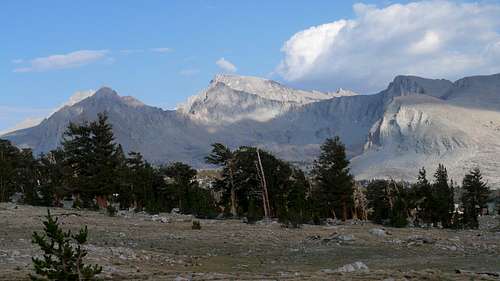|
|
Mountain/Rock |
|---|---|
|
|
36.58120°N / 118.3266°W |
|
|
Hiking, Mountaineering, Scrambling |
|
|
Spring, Summer, Fall |
|
|
13177 ft / 4016 m |
|
|
Overview
Adjacent to Mt Hale in the southern High Sierra, Mt Young anchors the long east to west ridge that includes such peaks as Mt Carillon, Mt Russell, Pk 4245 (some also call this peak "Mt Morgenson", and Mt Hale. Mt Young was one of several peaks named by the Reverend Fred H. Wales during his expedition with Capt James Wright and William Wallace. Similar to Mt Hale, the mountain is named after another noted astronomer, Charles Augustus Young, who is chiefly known for his work on solar spectroscopy.Most people choose to combine Mt Young with Mt Hale as they are separated by less than a mile and 500 feet of elevation. The easiest approaches are Class 1/2 and for an experienced hiker, the peak can be summited in a day from the Whitney Portal. Mt Young and Mt Hale share a common plateau immediately northwest of the Whitney massif and west of Mt Russell.
Getting There
 West face of Mt Hale (center) and the north face of Mt Young (far right) viewed from the Bighorn Plateau. The Northwest face of Mt Whitney looms immediately behind Mt Hale
West face of Mt Hale (center) and the north face of Mt Young (far right) viewed from the Bighorn Plateau. The Northwest face of Mt Whitney looms immediately behind Mt HaleLike Mt Hale, Mt Young can be approached from three directions: North Fork of Lone Pine from the east, the John Muir Trail from either the east or the west, or from the Wallace Creek basin from the west. The North Fork approach offers the most options for the scrambler while the Wallace Creek basin provides for access to the north face or the long western ridge. For most of the approaches, the obvious trailhead is the Whitney Portal.
- The North Fork variant approaches the mountain along the Arctic Lake valley flanked by Mt Whitney’s North Slope on one side and the vertical buttresses of Mt Russell on the other. Access to Arctic Lake requires either crossing the Whitney-Russell Col (good use trail) by Iceberg Lake or the Sakai Col high above Upper Boy Scout Lake.
- The Main Trail variant from the Whitney Portal crosses Trail Crest after the 99 switchbacks and descends the John Muir Trail to access the plateau from either the east or the south.
- The Wallace Creek basin can be approached from the John Muir Trail from the north or south.
Routes

East Slope: Class 2. This is a straight forward climb to the plateau from Arctic Lake or Guitar Lake. The Arctic Lake approach involves a 200’ drop before climbing the slope up to the plateau. There are at least two options from Arctic Lake that avoid the drop: “Michaels” Chute is a Class 2/3 gully to the right of the main slope and can be approached by traversing from Arctic Lake. “Bobs” chute is a Class 3+ gully (hidden from Arctic Lake) that can be accessed just before entering “Michael’s” Chute. All three variants exit onto the plateau; however, the chutes exit closer to Mt Hale and should only be used if Mt Hale is climbed first.
South Slope: Class 1. A straight forward hike up to the plateau from the John Muir Trail before reaching Guitar Lake. This is probably the preferred route if hiking the JMT south to north.
West Ridge: Class 1. This appears to be a straight-forward slog up from the Wallace Creek basin, over the bump at 10800’, and then up the southwest ridge of Mt Young. If approaching from JMT South, it may be preferable to hike to Sandy Meadows (high point between Crabtree Meadows and Wallace Creek) before heading east and climbing the west ridge.
Red Tape , Camping, and Conditions
 The view of the plateau from Mt Young's summit. The Class 2 exit east is center foreground in front of Whitney. The Class 1 exit south is in the far right portion of the picture with Guitar Lake below.
The view of the plateau from Mt Young's summit. The Class 2 exit east is center foreground in front of Whitney. The Class 1 exit south is in the far right portion of the picture with Guitar Lake below.Everything you need to know about permits, regulations, and driving directions can be found on the Eastern Sierra - Logistical Center page or the Mt Whitney Portal Store BBS. Both the North Fork Lone Pine (NFLP) and the Main Whitney Trail (MWT) require day hiking and overnight permits.
Camping in the Mt Whitney drainage is limited to the following locations: Upper Boy Scout Lake (NFLP), Iceberg Lake (NFLP), the Arctic Lake basin (NFLP), Outpost Camp (MWT), and Trail Camp (MWT).
Climbing can be done in almost any season but May through October are the most popular times. In heavy snow years, the East slope, especially the chutes, may hold residual snow. This is also true for any of the routes over the Sierra Crest. Check for current weather.
External Links
Trip Reports:
2007 Sierra Challenge Day 9
Pictures:
My pics & TR


